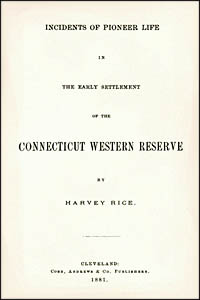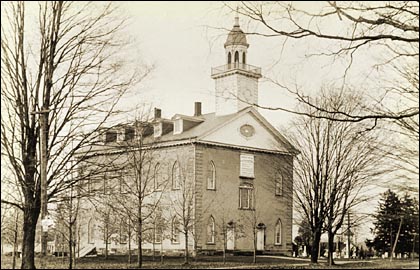|
[ 258 ]
CHAPTER XXVII.
_______
Little things -- Joe Smith -- Discovery and translation of the Golden Plates or
Book of Mormon -- Novel written vy Solomon Spaulding -- How Rev. Sidney Rigdon obtained
the manuscript -- Scheme of Smith and Rigdon -- Latter Day Saints -- Temple at Kirtland --
Removal to Nauvoo -- Flight into the Western Wilderness -- Salt Lake City -- The prophet.
_______
Lake county is a little county, famous for "many little things," some of which are really great things in a
certain sense. For instance, there is the little town of Kirtland, snugly ensconced among the hills, which
has a wide and lasting fame, if not an enviable one. It is the veritable "cradle of Mormonism." As to the
origin of this new religious faith, different versions have been given.
One version is that it originated with Joe Smith, who was afterwards aided in his schemes by equally unscrupulous
men. But little is known of Smith's early career in life. It has
PIONEER LIFE.
259
been ascertained, however, that he was born in Vermont, in 1805, of humble parentage. His education was sadly
neglected by his parents; yet as he grew to manhood he evinced a degree of native tact and talent, which was
truly remarkable. He had not only an inquisitive mind, but a "vaulting ambition" to acquire public notoriety.
He delighted in discussing theological subjects, and assumed that he was endowed with the "gift of prophecy."
In proof of this gift, he practiced the "divining art" with considerable success in the rural districts of his
own neighborhood, and especially among the unsophisticated farmers. He always carried with him a mysterious
looking rod, which he called a "divining rod," and by the tremulous motion of which he could determine just the
spot where persons wishing to dig a well could strike upon an ample spring of living water. Many wells were dug
with equal success without his divinations. He also carried with him a "mineral rod," by whose attractive power
he claimed to detect the spot where hidden treasures had been buried in the earth, and in fact insisted that he
had, in this way, discovered several places where large amounts of gold and silver had been concealed
260
INCIDENTS OF
during the Revolution and at subsequent periods. His "fame went abroad," and he traveled through the country to
a considerable extent, practicing his mysterious arts and delivering lectures. He held public meetings at
Palmyra, N. Y., and in other towns, at which he explained, in a plausible way, the gift of divination which he
had employed with unprecedented success. He soon found himself sustained by an extensive circle of believers.
Finding this to be the fact, he at once assumed the character of a prophet, and declared that to him had been
given a divine commission, authorizing him to announce to the world a new revelation for the salvation of mankind.
In order to give sanction to the comission, which he had received, he asserted that he had been guided by an
angel from heaven to a secluded nook in the hillside, near Palmyra, where he was directed to make an excavation
to a certain depth. This he did, and the result was that he discovered at the depth prescribed, a stone box in
which was inclosed a deposit of gold plates, engraved with strange characters, hitherto unknown to any human
tongue or alphabet. The angel declared the contents of the plates to be a message sent from heaven to the children
of men; and giving the prophet a small illuminating stone, informed him that by placing it in his hat, in
connection
PIONEER LIFE.
261
with each of the plates in succession, he would instantly become endowed with the "gift of tongues" and the
ability to translate the language of the plates into English. The angel then disappeared as mysteriously as
he came. Following the directions he had received from the angel, the prophet succeeded in translating the
graven plates into plain English, as he asserted. It is this translation of the divine message from heaven,
which constitutes the "Golden Bible" or "Book of Mormon," or in other words, the Holy Scriptures of the
"Latter Day Saunts."
A much more probable version, than the foregoing, has been given of the origin of this new revelation. Some years
previous to the marvelous announcement made by Joe Smith, a liberally educated gentleman, by the name of
Solomon Spaulding, a native of Conneticut, came to Conneaut, Ohio, and entered into co-partnership with his
brother John, who was a merchant, doing business at that place. They subsequently failed as merchants, Solomon's
health became seriously impaired, and by way of amusing himself, while in a failing condition of health, wrote
a historical romance or fiction, which was purely imaginary, but written in a scriptural style of language. He
entitled his work, "The Manuscript Found."
262
INCIDENTS OF
In this fiction he assumed that the American Indians were descendants of the Jews, or "lost tribes," of whom he
gives a detailed account of their wandering journey from Jerusalem by land and by sea, until they arrived in
America under command of Nephi and Lehi. He also describes the career of these lost tribes, after they arrived
in America, their quarrels and contentions, their division into two Nations, known as Nephites and Lemanites,
their arts and civilization, their religious rites and ceremonies, and their subsequent cruel and bloody wars,
in which great multitudes of them were slain and buried in mounds. It was in this way that he accounted for the
origin of the American Indians.
It is well known that Solomon, the author of "The Manuscript Found," read parts of his work, while engaged in
writing it, to his brother John, who professed to be quite delighted with its originality, and with its scriptural
style of language, and who did not hesitate to advise its publication. This encouraging estimate of the work
induced its author, in 1816, to visit Pittsburgh with a view of securing a publisher. It is supposed that he
succeeded in making an arrangement for the purpose with the printing firm of "Patterson and Lambdin," and that he
left his manuscript with them. Soon after this he visited Amity, Pa., where he was taken suddenly ill, and died.
PIONEER LIFE.
263
No more was heard of the manuscript for a good number of years.
In 1824 [sic - 1822?] Sidney Rigdon visited Pittsburgh, and remained for some three years, as a student of
theology. In the meantime, he made the acquaintance of Lambdin, of the printing firm, and became his intimate
friend. By this means he undoubtedly acquired possession of the manuscript. The firm became insolvent, and
L:ambdin soon afterwards died. The surviving partner, Patterson, stated that he knew nothing definite in relation
to this particular manuscript, but said that Lambdin, his former partner, took charge of all manuscripts left
with the firm for inspection, and that a large mass of such manuscripts still remained, unread, upon their
shelves, at the time of Lambdin's death. On receiving this information, the widow of Spaulding caused doligent
search to be made for the desired manuscript, but it could not be found among the manuscripts remaining upon
the shelves. This fact, in connection with subsequent developments, renders it certain that the missing manuscript
had passed into the hands of Rigdon, by some means or other, but in what way could not be definitely ascertained.
In the year 1827, Rigdon left Pittsburgh and commenced his career as a preacher, and soon acquired a wide
reputation as a controversialist.
264
INCIDENTS OF
He then began to promulgate new theories and strange doctrines. He had eventually conceived the idea of constructing
a new religious creed. Soon after this, while preaching at Palmyra, N. Y., and its vicinity, he made the
acquaintance of Joe Smith, who professed to have the gift of prophecy, and found in him a kindred spirit. They
became intimate, and soon afterwards projected the scheme by which the "Book of Mormon" was announced to the
world as a Divine revelation. But is so happened that John Spaulding, the brother of Solomon Spaulding, and
Henry Lake, had heard Solomon read his romance, entitled "The Manuscript Found," at different times previous to
his death. They have both testified that they read read the Book of Mormon, or Golden Bible, soon after it was
published, and were surprised to find that it contained but little more than a repetition of the story related
in the "Manuscript Found" of Solomon Spaulding, which they had heard him read. This fact convinced them that
Rigdon had, in some way, come into possession of Spaulding's work, and had contrived, with the aid of Joe Smith,
to give it the sanction of a new gospel by means of a miraculous discovery, as announced. Rigdon was a scholar,
and doubtless revised the manuscript so as to adapt its story to his purpose. Joe Smith performed the "miracle"
of translating it from
PIONEER LIFE.
265
the golden plates. The truth of the matter is, that Rigdon was a man of learning, an aspirant for fame, acute
and eloquent, while Smith was an ignoramus of low cunning, shrewd and plausible, and ambitious of being regarded
as possessed of miraculous powers. Yet both were, in fact, nothing more than cinsummate "impostors."
On the announcement of the new gospel and its publication in book form, the curiosity of the public was very
generally awakened. The Book of Mormon, or Golden Bible, as the publication was called, sold rapidly, and quite
a number of credulous persons immediately embraced the new faith. They assumed the name of the "Latter Day Saints,"
and continued to increase in numbers. The leaders constituted the hierarchy of "Mormonism," and received
accessions to their number, from time to time, of such professed converts as seemed to posses the requisite "tact
and talent."
A colony of these "Latter Day Saints," under the guidance of Rigdon and Smith, took their departure from Palmyra,
and arrived at Kirtland, Ohio...
(under construction)
|


